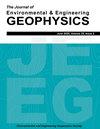Automated Segmentation Framework for Asphalt Layer Thickness from GPR Data Using a Cascaded k-Means - DBSCAN Algorithm
IF 0.7
4区 工程技术
Q4 ENGINEERING, GEOLOGICAL
引用次数: 0
Abstract
Timely monitoring of pavement sub-surface layer thickness and condition evaluation is essential to ensure stable pavement performance and safety under heavy traffic loading. In addition, accurate estimation of pavement layer thicknesses is required for condition evaluation, overlay design/ quality control assurance, and structural capacity evaluation of existing pavements to predict its remaining service life. Traditionally this vital information is ascertained through coring/drilling and visual inspections. In contrast to these current techniques, ground-penetrating radar (GPR) is a non-destructive technique gaining popularity in pavement asphalt layer thickness estimation and structural condition monitoring. Its high-quality data contains vital pavement condition information, and survey costs are reasonably economic. In this work, GPR data were acquired along a toll road in Queensland, Australia, using the GSSI 4-channel SIR30 GPR unit. Asphalt layer thickness information is considered an important input parameter for condition assessment, pavement performance, and lifetime modelling. This work presents an automated segmentation framework to evaluate pavement conditions for a large pavement network. The developed algorithm uses GPR asphalt thickness data as input and generates segments with decision boundaries utilising a cascaded k-means and DBSCAN approach that works in two steps: 1) centroid initialisation using k-means algorithm, 2) clustering using DBSCAN algorithm. Presented in this paper is the workflow of the cascaded method that is applicable to automated analysis of GPR asphalt thickness data. The performance of the cascaded k-means and DBSCAN algorithm was evaluated in terms of entropy compared with traditional k-means and traditional DBSCAN algorithms. The results show that the proposed method outperforms its constituents. Based on the results of this study, the method presented in this paper is cost-effective, economical and robust for segmenting large pavement network with GPR data.基于级联k-Means - DBSCAN算法的GPR数据沥青层厚度自动分割框架
对路面亚表面层厚度进行及时监测和状态评价,是保证路面在大交通荷载作用下性能稳定、安全可靠的关键。此外,对现有路面进行状态评估、覆盖层设计/质量控制保证和结构能力评估,预测其剩余使用寿命,都需要准确估算路面厚度。传统上,这些重要信息是通过取心/钻孔和目视检查来确定的。与这些现有技术相比,探地雷达(GPR)是一种非破坏性技术,在路面沥青层厚度估算和结构状态监测中越来越受欢迎。它的高质量数据包含了重要的路面状况信息,调查成本也相当经济。在这项工作中,利用GSSI的4通道SIR30探地雷达装置,沿着澳大利亚昆士兰州的一条收费公路获取了探地雷达数据。沥青层厚度信息被认为是条件评估、路面性能和寿命建模的重要输入参数。这项工作提出了一个自动分割框架来评估大型路面网络的路面状况。开发的算法使用GPR沥青厚度数据作为输入,并利用级联k-means和DBSCAN方法生成具有决策边界的段,该方法分两步工作:1)使用k-means算法进行质心初始化,2)使用DBSCAN算法进行聚类。本文介绍了适用于探地雷达沥青厚度数据自动分析的级联方法的工作流程。通过与传统k-means和传统DBSCAN算法的熵比较,对级联k-means和DBSCAN算法的性能进行评价。结果表明,该方法的性能优于其他方法。研究结果表明,本文提出的方法对于利用探地雷达数据分割大型路面网具有成本效益、经济性和鲁棒性。
本文章由计算机程序翻译,如有差异,请以英文原文为准。
求助全文
约1分钟内获得全文
求助全文
来源期刊

Journal of Environmental and Engineering Geophysics
地学-地球化学与地球物理
CiteScore
2.70
自引率
0.00%
发文量
13
审稿时长
6 months
期刊介绍:
The JEEG (ISSN 1083-1363) is the peer-reviewed journal of the Environmental and Engineering Geophysical Society (EEGS). JEEG welcomes manuscripts on new developments in near-surface geophysics applied to environmental, engineering, and mining issues, as well as novel near-surface geophysics case histories and descriptions of new hardware aimed at the near-surface geophysics community.
 求助内容:
求助内容: 应助结果提醒方式:
应助结果提醒方式:


